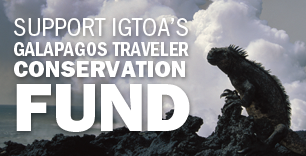Search
Tag Cloud
Subscribe
Can Regenerative Tourism Save the Galapagos?

Earlier this month, I had the privilege of representing IGTOA at a three-day tourism workshop in Puerto Ayora. The workshop, titled "A path towards tourism that helps conserve biodiversity and build the island society in the Galapagos," was hosted by Galapagos National Park, Cambridge University, the University of San Francisco de Quito and Talking Transformations. The stated goal of the event was to “Outline a way for tourism to become a regenerative force for the ecosystem and society of the Galapagos” and to make the group's findings available to policy makers, stakeholders and the general public. The concept of regenerative tourism
I will report on the group’s official recommendations when they are released in September. You can learn more about regenerative tourism and the objectives of the meeting in this document put out by the workshop’s organizers.
The three day event was attended by a wide variety of Galapagos stakeholders, including representatives from local tourism companies, vessel operators, NGOs, the national park, the ministry of tourism and the governing council of the Galapagos, and many guides. The agenda included presentations by regenerative tourism experts and local leaders, seminars on the history of tourism in the Galapagos and previous and current efforts to regulate it, a panel discussion with the heads of the national park, the Consejo de Gobierno (the governing council of the Galapagos) and the Ministry of Tourism in Galapagos, as well working group sessions in which participants broken into smaller groups and debated various policy ideas and proposals.
It also included field trips to experience some innovative regenerative tourism projects, including a working coffee farm and Frente Insular, a non-profit which promotes community activism and education for young people, which IGTOA has helped support financially.

The conference came on the heels of the State of Conservation Report published on the UNESCO website in July, which cited land based tourism growth and the absence of a clear plan to address it as an issue of global concern. In 2007, UNESCO took the extraordinary step of placing the Galapagos on its List of World Heritage in Danger, citing uncontrolled tourism growth and the lack of a clear plan to address it as a primary factor in its decision. Although it was removed from the list in 2010, tourism growth has continued unabated: in April of this year, Ecuador’s Ministry of Tourism celebrated the fact that March visitor numbers had surpassed 2019 numbers by nearly 25% and announced new flights to the Galapagos from the Manta, which will only exacerbate the problem.
It remains to be seen what, if any, impact the final recommendations the group generated will have on policy going forward, but most of the other participants I spoke with seemed to agree that the fact the workshop was happening at all seems positive and an indication that the issue of tourism growth is being taken seriously at the highest levels of government. There seemed to be general consensus among the attendees that the park entrance fee should be raised and that the crux of the tourism growth problem is the increase in land based tourism over the past two decades. (Interestingly, IGTOA’s recent call for the government of Ecuador to honor its commitment to a zero-growth tourism policy and to raise park fees was featured in the keynote address by Dr. Carter Hall of Penn State University.
The workshop also highlighted how tricky the issue of managing tourism growth is. Putting policies in place that will actually reduce or cap visitor arrivals is politically and economically complicated. For example, land based tourism growth in recent years has been exacerbated by safety concerns in traditional beach destinations on the mainland, which has resulted in more Ecuadorians coming to Galapagos for their family holidays. And of course, many people in the Galapagos own or are employed by businesses that primarily cater to more budget-oriented land based visitors, from both Ecuador and abroad. As such, raising the national park entrance fees and other potential policy solutions that could curb tourism growth are often understandably met with skepticism or downright hostility by many locals.
One take away I got from the conference is that while there are no simple solutions, moving away from a model of market-driven, unmanaged tourism growth to a more thoughtful one which prioritizes the health of the environment, the well being of local communities, and the quality of guest experiences would be a huge step in the right direction.






